Table of Contents
Top 10 Best Usual Animals In Queen Elizabeth National Park
Here we are looking at the top 10 best usual animals in Queen Elizabeth National Park and they are lions, African elephants, African buffalo, leopards, warthogs, Nile crocodile, hippopotamus, antelopes, spotted hyena and chimpanzees.
The top 10 best usual animals in Queen Elizabeth National Park are always found in this savannah park, which is located in western Uganda, Kasese district and was founded in 1952 by joining together the then Kazinga reserve to lake Edward and lake George thus forming the Kazinga National Park which was later on renamed Queen Elizabeth National Park in commemoration of the visit of Queen Elizabeth II of England in Uganda.
Queen Elizabeth National Park has over 90 mammal’s species including the four of the big fives and it’s the leading birding site in Uganda with 600 bird species. Queen Elizabeth is common for its climbing lions at the Ishasha sector. A remarkable wildlife experience and a boat cruise at the Kazinga channel are a must do when you get to this wonderful park. there are also many animals in Murchison falls national park. The following are the Top 10 Usual Animals in Queen Elizabeth National Park.
1. Lions in Queen Elizabeth National Park
Lions are among the top 10 usual animals in Queen Elizabeth National Park. lions are carnivores’ animals and belong to the cat family. These are largest animals in the cat family and are one of the big five. Lions’ gestation period is about 108 days. These do not chew their food; they have small incisors at the front of their mouth used to grip the meat whilst their sharp carnassial teeth in back of their mouth tear it into chunks and then they swallow. Queen Elizabeth National Park has about 130 lions.
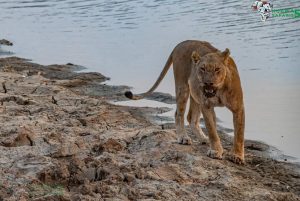
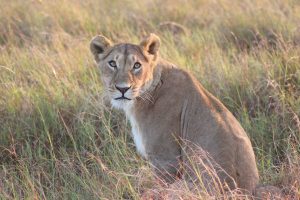
Climbing lions are one of the interesting mammals to see when you visit the park. In Uganda, climbing lions are only found in Queen Elizabeth National Park, the Ishasha sector. Climbing lions are see during game drives in Ishasha sector of the park, hang lazily on large fig tree.
Climbing lions climb tree branches for the clear view on wide scale of the savanna plains. What is Queen Elizabeth National Park famous for? these are climbing lions.
The best time to see lions is during the morning game drive before they disappear in the wilderness. Note that when you visit the park, lions are among the top 10 Usual Animals In Queen Elizabeth National Park you expect to see.
2. African elephants in Queen Elizabeth National Park
Elephants are among the top 10 usual animals in Queen Elizabeth National Park. Expect to see African Elephants when you visit the park, and they are among the big five. They have six sets of molar teeth and when the last set is lost, they are unable to eat and eventually die. Gestation period is almost two years or less than.
Elephants spend about 16 hours a day eating and can consume up to 300 kilograms of food. These are also among the animals in Kidepo national park.
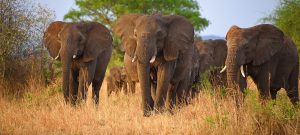
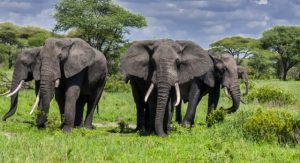
They leave up to 70 years and are also known as World’s largest land animal. Elephants give birth every three to four years. Elephants live in tight social units led by an older matriarch (female), males leave in herd between the age of 12 and 15. However are among the Top 10 Usual Animals in Queen Elizabeth National Park.
3. African Buffalo in Queen Elizabeth National Park
Buffalos are among the top 10 usual animals in Queen Elizabeth National Park. The African buffalo is a large sub-Saharan African bovine, and they live in large herds on savanna and smaller herds in forested areas. An interesting behavior observed in African buffaloes is seemingly altruistic partnership and belong to Bovidae family. The mud baths are very important buffalos because the mud cover in the skin, regulates body temperature and repels ecto-parasites and flies.
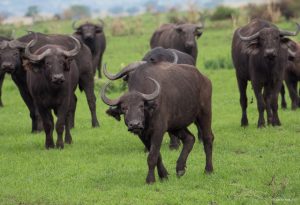
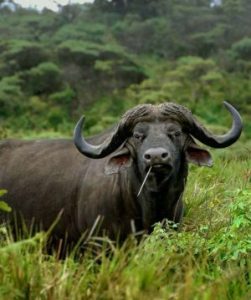
This enables the animal to tolerate air temperatures of up to 40°c.There are five subspecies that are recognized as being valid. They have placement eyes, ears, and nostrils high on their head which allows them to remain mostly submerged while still being able to breathe and stay aware the surroundings.
Gestation period in buffalo is longer than cattle, varying from 305 to 320 days for the river buffalo and 320 to 340 days for the swap buffalo. The requirements required for the Africa buffalos are abundant tall, sweet grass species, mud bath, trees for refuge, sufficient shrub and ample surface water.
4. Spotted hyena in Queen Elizabeth National Park
The spotted hyenas are also among the top 10 usual animals in Queen Elizabeth National Park, and are also called the laughing hyena, it’s the most common large carnivore in Africa and their gestation period is 110 days. They are four types of species striped hyena (hyaena hyaena). The brown hyena (Para hyaena brunnea), the spotted hyena (crocuta crocuta) and the aardwolf (proteles cristate).
Spotted hyenas are skilled hunter as well as scavengers, their sound of laughing is a sound made to inform the group members to a source of food and noise can be heard up to three miles away. Spotted hyenas are one of the best mothers in animal kingdom, they give birth from 1-3 jet black cubs, and they are amazingly intelligent.
Though are among the Top 10 Usual Animals in Queen Elizabeth National Park. In Queen Elizabeth National Park, Ishasha plains is one the finest wildlife destination in the world. It offers the good chances of filming the spotted hyenas.
5. Antelopes in Queen Elizabeth National Park
Antelopes in Queen Elizabeth National Park are among the top 10 usual animals in Queen Elizabeth National Park, and classified in different types like reedbuck, sitatunga, Topi, Uganda Kob, duiker, bushbuck, waterbuck, etc. the Uganda Kobs are the most common and their gestation period is 7.5 to 9 months.


The waterbucks are also very common, and they are light grey to reddish-brown also darkens when old. these live near water sources, have large ears with beautiful white marking around their neck, nose, mouth and above the ears. the live in shrubs and grassy plains.
However, they are among the top ten animals in Queen Elizabeth National Park. Antelopes belong to Bovidae family, deer-like behaviors, long legs, a slender neck, large ears and they are found in wide ranges habitants like savannah, woodland, swamps, rain forests and steppes.
6. Leopards in Queen Elizabeth National Park
Leopards are among the top 10 usual animals in Queen Elizabeth National Park. In Queen Elizabeth, leopards have sharp teeth, strong jaws, powerful bodies, they are notoriously shy, skilled climbers, eat prey, and belong to the Felidae family. They have a gestation period of 90-105 days, and they grow up to 6.2 feet, their tail adds more 25-36 inches.
A male leopard usually weighs around 36-75 kg, and a female leopard typically weighs 21-60 kg. Leopards are nocturnal i.e., they are active during night, and they are solitary creatures. When the cubs reach 2 years 0ld, they begin to disperse from their mothers and set out on their own.
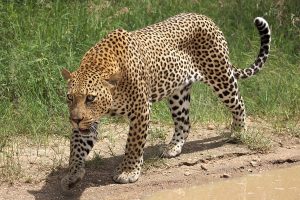

But leopards are among the Top 10 Usual Animals in Queen Elizabeth National Park. Their sounds are similar to other large cats though leopards cannot roar due to the physiology of their throat.
In order for communication, they scrape the ground with their hind legs after they spray urine against rocks to mark territory or locate mates and also leave markings on the land scape that other cats will find. Leopards are mostly situated near Muhokya village.
7. Warthogs in Queen Elizabeth National Park
A warthog is a wild member of the pig family found in savanna grassland and savanna woodland. Their scientific name is Phacochoerus, always the common warthogs do not dig their burrows, males are always solitary in their wild and females make family group or sounders and their young ones. These are commonly among the top 10 usual animals in Queen Elizabeth National Park.
Common warthogs are light grey to brown color, they have three pairs of ‘warts’ are along their faces .A male adult weighs 60-150 kg and a female adult weighs 45-75 kg, gestation period is 152-183 days. They belong to Animalia kingdom, they have large, flat heads which are covered with ‘warts’ which are protective bumps.
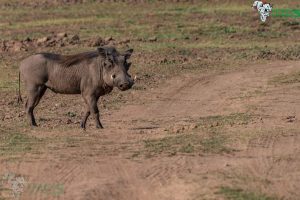
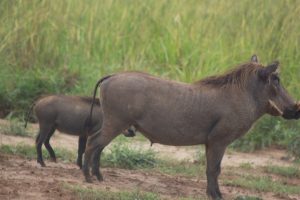
However, are among the Top 10 Usual Animals in Queen Elizabeth National Park. Warthogs reach sexual maturity by 18 to 24 months of age and live 15 years in the wild, breeding season always occurs in the spring right after rainy season and males typically will not mate until they are 4 years old.
Warthogs which are young remain in their burrows about 6-7 weeks, warthogs are not aggressive animals and therefore they usually pose no threat to humans.
8. Nile crocodiles in Queen Elizabeth National Park
The Nile crocodiles are the large crocodilian native to freshwater habitats in Africa. It is considered in 26 countries, it is the largest water predator in Africa, they are the one of the most dangerous species of crocodile and is responsible for hundreds of human deaths every year. They are among the top 10 usual animals in Queen Elizabeth National Park.
Female sexual maturity occurs when they reach 2.2-3 m (7ft 3in to 9ft 10in) and for the males’ sexual maturity 0ccurs when they are about 3.3m (10ft) long and mass of 155kg. Sexual maturity is obtained from 12-16 years of age.
During mating season, male attracts female by slapping their snouts in the water, bellowing, blowing water out of their noses, and making a variety of other noises. Territorial clashes can lead to physical fighting between males especially when they are near the same sizes. However, are among the Top 10 Usual Animals in Queen Elizabeth National Park.
9. Hippopotamus in Queen Elizabeth National Park
The hippos inhabit water bodies within Queen Elizabeth National Park like Kazinga channel, lake George, lake Edward, river Ishasha, river Kyambura and crater lakes like lake Nyamusingiri, Kyasanduka among others.
The clear viewing of these hippos is easily required by using binoculars, though they are the third largest animals on the land and herbivorous mammals physically they resemble pigs, but they have hairless bodies, a wide-open mouth, live in fresh waters, columnar legs, large size, the average weight is around for the adult males and females is around 1500kg and around 1300kg.
The hippos have stocky shaped and short legs, and they are able to run around 30 kilometers, their gestation period is 8 months, they always hike at night and graze after they return back to water in the morning where they can live near each other. The hippo census begins in the evening hours since it’s the right time when hippos move out to feed and back to water in the morning.
Hippopotamus means the river horse and they get old by 50 years, they change their resting places once or twice a week, grayish brown above, lighter and pinkish below. Hence making them among the Top 10 Usual Animals in Queen Elizabeth National Park. These are also among the top 10 usual animals in Queen Elizabeth National Park.
The female hippo reaches the sexual maturity at the age of 5-6, they are grouped in groups called schools, pods, herds and a bloat. Though hippos live in those pods by a number of 10-30 members, consisting of both males and females although some groups have as many as 200 hippos, no matter how big the pod is, it is led by one dominate male.
10. Chimpanzees in Queen Elizabeth National Park
Chimpanzees are also found in Queen Elizabeth National Park, they share 98.8%-99% of the human DNA showing that they are the first cousins of human. There are habituated and non-habituated chimpanzees in Queen Elizabeth National Park. They are mainly tracked in Kyambura Gorge also known as the valley of Apes. They belong to Hominidae family. They are among the top 10 usual animals in Queen Elizabeth National Park and they are also common in Bwindi Impenetrable National Park.
Their gestation period takes 8 months, and they give birth to one individual, twins are very rare. Chimpanzees’ skin gets dark when they become old, female chimpanzee take a very good care of their babies. Their long arms help them to rest their weight and, on the knuckles, as they move.
They live in 20-120 individuals, can avoid strong diseases that human can’t avoids live Ebola, malaria. Chimpanzees in the wild live less than 27 years while, however in captivity they can live up to 70 years.
Other attractions in Queen Elizabeth National Park
There are different attractions that are found in Queen Elizabeth National Park, and they are located in different places which are explained below.
- Kyambura Gorge
Kyambura Gorge is found in the eastern part if the park and its mainly for Chimpanzee trucking in the valley of apes. it is of the places where the primates, red tailed monkeys, olive baboons, white colobus monkeys, birds and others can be found in Queen Elizabeth National Park.
Due to its beautiful as being sheltered by the riverine forests. Activities are game viewing, birding and others.
- Mweya peninsular
This is situated in the heart of Queen Elizabeth National Park and the best destination for game drives where is good to see different bird species and various animals like leopards, elephants, and others.
Mweya peninsular also offers accommodation facility which is luxurious called Mweya safari lodge where visitors stay during their safari in Queen Elizabeth National Park.
- The Ishasha sector
This sector is known due for being famous of the unique tree climbing lions, whereby it is consisted of candelabra trees which have big branches, and these helps the lions to hang up there. This Ishasha sector is located in Southwestern rim of the Queen Elizabeth National Park and in western of Uganda.
The dry season is the best time to visit the Ishasha sector due to the dry roads and clear environment between June to September. However, the Ishasha sector is also open for visitors all throughout the year.
- Kazinga Channel
This Kazinga Channel is located in Kasese district, with in Queen Elizabeth National Park. It is 32km long and it joins two freshwater bodies lake George and Lake Edward. The boat cruise takes 2hours along the Kazinga Channel. Most birds in Queen Elizabeth national park are found in the Kazinga Channel
During the boat cruise, you are free to carry out different activities like building, animals especially Nile crocodiles, hippos and African elephants.
How to get to Queen Elizabeth National Park
Queen Elizabeth National Park is the second largest park after Murchison falls national park. it can be accessed by two means of transport such as road transport and air transport. Here is the Queen Elizabeth National Park location.
- Road transport.
Queen Elizabeth National Park can be accessed from Kampala will take at least eight hours along a tarmac road. There are two routes from Kampala, via Mbarara to the east of the park [covers distance of 250 miles], or Fort Portal to the north [covers slightly longer at 260 miles]. Most visitors choose to include stops at other parks along the way rather than driving direct from Kampala to Queens.
- By Air.
Queen Elizabeth National Park can also be accessed by air from both Entebbe International Airport, the country’s international airport mainly the starting point, and the Kajjansi Airfield near Kampala.
The closest airports to Queens are Kasese, Mweya and Ishasha. Uganda’s domestic flight network offers a range of scheduled direct flights, and aircraft can also be chartered. The flight time is generally two to three hours.
Frequently Asked questions
What animals can you see in Queen Elizabeth National Park?
- Climbing lions
- African elephants
- Leopards
- Buffalo
- Hippopotamus
What is unique about Queen Elizabeth National Park?
- It has four of the big five.
- Second largest park in the world
Are there lions in Queen Elizabeth National Park?
- The park has over 250 large cats in both the northern and southern sector.
- Queen Elizabeth National Park has the largest population of tree climbing lions.
Conclusion
Queen Elizabeth National Park is the second largest park after Murchison falls national park. And all activities explained above can be carried out throughout the year. Enjoy your safari or vacation in Queen Elizabeth National Park any time. Get good experience with Kubwa 5 Safari.

